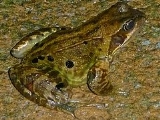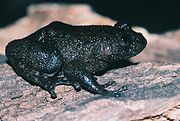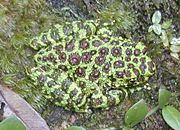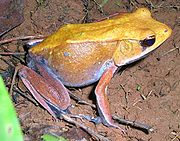
True frog
Encyclopedia
The true frogs, family
Ranidae, have the widest distribution of any frog
family. They are abundant throughout most of the world, occurring on most continent
s except Antarctica. The true frogs are present in North America
, northern South America
, Europe
, Asia
, Madagascar
, Africa
, and from the East Indies
to New Guinea
; the species
native to Australia
—the Australian Wood Frog
(Hylarana daemelii)—is restricted to the far north.
Typically, true frogs are smooth, moist-skinned frogs, with large, powerful legs and extensively webbed feet. The true frogs vary greatly in size, ranging from small—such as the Wood Frog
(Rana sylvatica)—to the largest frog in the world, the Goliath frog
(Conraua goliath).
Many of the true frogs are aquatic or live close to water. Most species lay their eggs in the water and go through a tadpole stage. However, as with most families of frogs, there is large variation of habitat
within the family. Those of the genus Tomopterna
are burrowing frogs native to Africa and exhibit most of the characteristics common to burrowing frogs around the world. There are also arboreal species of true frogs, and the family includes some of the very few amphibian
s that can live in brackish water
.
is actually a distinct family called Petropedetidae. The validity of the Cacosterninae is likewise disputed; they are usually merged in the Petropedetinae but when the latter are considered a distinct family the Cacosterninae are often awarded at least subspecific distinctness too, and sometimes split off entirely. Still, there is general agreement today that the Mantellidae
, which were formerly considered another ranid subfamily, form a distinct family. There is also a recent trend to split off the forked-tongued frogs as distinct family Dicroglossidae again.
In addition, the delimitation and validity of several genera
is in need of more research (though much progress has been made in the last years). Namely how the huge genus Rana
is best split up requires some more study. While the splitting-off of several genera—like Pelophylax
—is rather uncontroversial, the American bullfrog
s formerly separated in Lithobates
and groups like Babina or Nidirana represent far more disputed cases.
While too little of the vast diversity of true frogs has been subject to recent studies to say something definite, as of mid-2008 studies are ongoing and several lineages are recognizable.



Family (biology)
In biological classification, family is* a taxonomic rank. Other well-known ranks are life, domain, kingdom, phylum, class, order, genus, and species, with family fitting between order and genus. As for the other well-known ranks, there is the option of an immediately lower rank, indicated by the...
Ranidae, have the widest distribution of any frog
Frog
Frogs are amphibians in the order Anura , formerly referred to as Salientia . Most frogs are characterized by a short body, webbed digits , protruding eyes and the absence of a tail...
family. They are abundant throughout most of the world, occurring on most continent
Continent
A continent is one of several very large landmasses on Earth. They are generally identified by convention rather than any strict criteria, with seven regions commonly regarded as continents—they are : Asia, Africa, North America, South America, Antarctica, Europe, and Australia.Plate tectonics is...
s except Antarctica. The true frogs are present in North America
North America
North America is a continent wholly within the Northern Hemisphere and almost wholly within the Western Hemisphere. It is also considered a northern subcontinent of the Americas...
, northern South America
South America
South America is a continent situated in the Western Hemisphere, mostly in the Southern Hemisphere, with a relatively small portion in the Northern Hemisphere. The continent is also considered a subcontinent of the Americas. It is bordered on the west by the Pacific Ocean and on the north and east...
, Europe
Europe
Europe is, by convention, one of the world's seven continents. Comprising the westernmost peninsula of Eurasia, Europe is generally 'divided' from Asia to its east by the watershed divides of the Ural and Caucasus Mountains, the Ural River, the Caspian and Black Seas, and the waterways connecting...
, Asia
Asia
Asia is the world's largest and most populous continent, located primarily in the eastern and northern hemispheres. It covers 8.7% of the Earth's total surface area and with approximately 3.879 billion people, it hosts 60% of the world's current human population...
, Madagascar
Madagascar
The Republic of Madagascar is an island country located in the Indian Ocean off the southeastern coast of Africa...
, Africa
Africa
Africa is the world's second largest and second most populous continent, after Asia. At about 30.2 million km² including adjacent islands, it covers 6% of the Earth's total surface area and 20.4% of the total land area...
, and from the East Indies
East Indies
East Indies is a term used by Europeans from the 16th century onwards to identify what is now known as Indian subcontinent or South Asia, Southeastern Asia, and the islands of Oceania, including the Malay Archipelago and the Philippines...
to New Guinea
New Guinea
New Guinea is the world's second largest island, after Greenland, covering a land area of 786,000 km2. Located in the southwest Pacific Ocean, it lies geographically to the east of the Malay Archipelago, with which it is sometimes included as part of a greater Indo-Australian Archipelago...
; the species
Species
In biology, a species is one of the basic units of biological classification and a taxonomic rank. A species is often defined as a group of organisms capable of interbreeding and producing fertile offspring. While in many cases this definition is adequate, more precise or differing measures are...
native to Australia
Australia
Australia , officially the Commonwealth of Australia, is a country in the Southern Hemisphere comprising the mainland of the Australian continent, the island of Tasmania, and numerous smaller islands in the Indian and Pacific Oceans. It is the world's sixth-largest country by total area...
—the Australian Wood Frog
Australian Wood Frog
The Australian wood frog , locally simply known as "the" wood frog, is the only species from the family Ranidae that occurs in Australia. The species is restricted to the rainforest of northern Queensland, the eastern border of Arnhem Land, in the Northern Territory and much of New Guinea...
(Hylarana daemelii)—is restricted to the far north.
Typically, true frogs are smooth, moist-skinned frogs, with large, powerful legs and extensively webbed feet. The true frogs vary greatly in size, ranging from small—such as the Wood Frog
Wood Frog
The Wood Frog has a broad distribution over North America, extending from the southern Appalachians to the boreal forest with several notable disjunct populations including lowland eastern North Carolina...
(Rana sylvatica)—to the largest frog in the world, the Goliath frog
Goliath frog
The goliath frog, Conraua goliath is the largest extant anuran on Earth. It can grow up to 33 cm in length from snout to vent, and weighs up to 3 kg . This animal has a relatively small habitat range, mainly in Cameroon and Equatorial Guinea...
(Conraua goliath).
Many of the true frogs are aquatic or live close to water. Most species lay their eggs in the water and go through a tadpole stage. However, as with most families of frogs, there is large variation of habitat
Habitat
* Habitat , a place where a species lives and grows*Human habitat, a place where humans live, work or play** Space habitat, a space station intended as a permanent settlement...
within the family. Those of the genus Tomopterna
Tomopterna
Tomopterna is a genus of true frogs from Sub-Saharan Africa.-Species:* Tomopterna cryptotis * Tomopterna damarensis Dawood & Channing, 2002* Tomopterna elegans* Tomopterna delalandii...
are burrowing frogs native to Africa and exhibit most of the characteristics common to burrowing frogs around the world. There are also arboreal species of true frogs, and the family includes some of the very few amphibian
Amphibian
Amphibians , are a class of vertebrate animals including animals such as toads, frogs, caecilians, and salamanders. They are characterized as non-amniote ectothermic tetrapods...
s that can live in brackish water
Brackish water
Brackish water is water that has more salinity than fresh water, but not as much as seawater. It may result from mixing of seawater with fresh water, as in estuaries, or it may occur in brackish fossil aquifers. The word comes from the Middle Dutch root "brak," meaning "salty"...
.
Systematics
The subdivisions of the Ranidae are still a matter of dispute, although many are coming to an agreement. Most authors believe the subfamily PetropedetinaePetropedetinae
Petropedetinae are a subfamily of frogs. They are placed in the true frog family by many authors. But this is quite disputed and at least part of this group is often treated as a distinct family Petropedetidae, in which case the Cacosterninae and Phrynobatrachinae are usually separated as...
is actually a distinct family called Petropedetidae. The validity of the Cacosterninae is likewise disputed; they are usually merged in the Petropedetinae but when the latter are considered a distinct family the Cacosterninae are often awarded at least subspecific distinctness too, and sometimes split off entirely. Still, there is general agreement today that the Mantellidae
Mantellidae
Mantellidae is a family of the order Anura. These frogs are found only in Madagascar and Mayotte.The habits, habitat and appearance of these frogs are widely variable. Most species are terrestrial, though some are arboreal or aquatic. Body size ranges from 3 to 10 centimetres in length...
, which were formerly considered another ranid subfamily, form a distinct family. There is also a recent trend to split off the forked-tongued frogs as distinct family Dicroglossidae again.
In addition, the delimitation and validity of several genera
Genera
Genera is a commercial operating system and development environment for Lisp machines developed by Symbolics. It is essentially a fork of an earlier operating system originating on the MIT AI Lab's Lisp machines which Symbolics had used in common with LMI and Texas Instruments...
is in need of more research (though much progress has been made in the last years). Namely how the huge genus Rana
Rana (genus)
Rana is a genus of frogs. Species include such archetypal pond frogs as the common frog of Europe, brown frogs, and the New and Old World true frogs, including the various species of leopard frogs and the American bullfrog. Members of this genus are found through much of Eurasia, North America,...
is best split up requires some more study. While the splitting-off of several genera—like Pelophylax
Pelophylax
Pelophylax is a genus of true frogs widespread in Eurasia, with a few species ranging into northern Africa. This genus was erected by Leopold Fitzinger in 1843 to accommodate the "green frogs" of the Old World, which he considered distinct from the brown pond frogs of Linnaeus' genus Rana.They are...
—is rather uncontroversial, the American bullfrog
Bullfrog
The American bullfrog , often simply known as the bullfrog in Canada and the United States, is an aquatic frog, a member of the family Ranidae, or “true frogs”, native to much of North America. This is a frog of larger, permanent water bodies, swamps, ponds, and lakes, where it is usually found...
s formerly separated in Lithobates
Lithobates
Lithobates is a subgenus of frogs of the genus Rana found in Central and South America.It was briefly proposed as a separate genus in 2006, but that was rejected in later studies.-Species:...
and groups like Babina or Nidirana represent far more disputed cases.
While too little of the vast diversity of true frogs has been subject to recent studies to say something definite, as of mid-2008 studies are ongoing and several lineages are recognizable.
- Genera like NyctibatrachusNyctibatrachusNyctibatrachus is a genus of true frogs endemic to India. It is a very ancient member of the true frog family, Ranidae.Their scientific name means "night frog", in reference to their habits and dark color.-Species:...
, StauroisStauroisStaurois is a small genus of true frogs. They occur from Borneo via Palawan to the Philippines.This genus is a quite ancient member of the true frog family, Ranidae.-Selected species:The Staurois natator complex is in need of revision....
, and the complex around EuphlyctisEuphlyctisEuphlyctis is a genus of true frogs.-Species:* Euphlyctis cyanophlyctis .* Euphlyctis ehrenbergii .* Euphlyctis ghoshi .* Euphlyctis hexadactylus ....
, HoplobatrachusHoplobatrachusHoplobatrachus is a genus of true frogs which has four described species.-Species:* Hoplobatrachus chinensis .* Hoplobatrachus crassus .* Hoplobatrachus occipitalis ....
, NannophrysNannophrysNannophrys is a genus of true frogs from Sri Lanka.-Species:* Nannophrys ceylonensis Günther, 1869.* Nannophrys guentheri Boulenger, 1882. * Nannophrys marmorata Kirtisinghe, 1946....
, Sphaerotheca and the paraphyletic FejervaryaFejervaryaFejervarya is one of the Asian genera of true frogs. First proposed in 1915 by István József Bolkay, a Jugoslavian naturalist of Hungarian descent also known as Stephan Bolkay, the genus did not see widespread adoption at first...
are probably very ancient offshoots of the main Raninae lineage. - AmolopsAmolopsAmolops is a quite large genus of true frogs native mainly to eastern and southeastern Asia. These frogs are quite closely related to such genera as Huia, Meristogenys, Odorrana, Pelohylax and Rana, but still form a distinct lineage among the core radiation of true frogs...
has been generally delimited as a monophyletic group. - OdorranaOdorranaOdorrana is a genus of true frogs from East Asia and surrounding regions. Many of these frogs inhabit fast-flowing mountain streams, and they typically have a remarkably pointed snout, as evidenced by common names like "long-snout" or "tip-nosed frog" and scientific names like nasica or nasutus...
and Rana plus some proposed minor genera (which probably ought to be included in the latter) form another group. - A group including ClinotarsusClinotarsusClinotarsus is genus of Ranid frogs containing at least two species. This genus was originally part of Rana. Members of this genus are found in India and Southeast Asia....
, HuiaHuia (genus)Huia is a group of true frogs found in Southeast Asia. Many are commonly known as "torrent frogs" after their favorite habitat - small rapid-flowing mountain and hill streams -, but this name is used for many similar-looking frogs regardless of whether they are closely related...
in the strict sense and MeristogenysMeristogenysMeristogenys is a genus of true frogs from Borneo. Its tadpoles are easily recognizable by their divided upper lip with ribs on the outside.... - An ill-defined assemblage of Babina, Glandirana, HylaranaHylaranaHylarana is a widespread genus of true frogs found in tropical Africa, Asia, and Australia. It includes around 86 species.-Taxonomy:Hylarana was previously considered to be a subgenus of the genus Rana. It was recognized as a distinct genus in 2005...
, Pulchrana, Sanguirana, Sylvirana, as well as Hydrophylax and PelophylaxPelophylaxPelophylax is a genus of true frogs widespread in Eurasia, with a few species ranging into northern Africa. This genus was erected by Leopold Fitzinger in 1843 to accommodate the "green frogs" of the Old World, which he considered distinct from the brown pond frogs of Linnaeus' genus Rana.They are...
which are probably not monophyletic. Most of them are now treated as junior synonyms of the genus HylaranaHylaranaHylarana is a widespread genus of true frogs found in tropical Africa, Asia, and Australia. It includes around 86 species.-Taxonomy:Hylarana was previously considered to be a subgenus of the genus Rana. It was recognized as a distinct genus in 2005...
.
Genera



- AfranaAfranaAfrana is a genus of true frogs.-Species:* Afrana amieti * Afrana angolensis — Angola River Frog, Common River Frog* Afrana desaegeri...
- Allopaa Ohler & Dubois, 2006
- AmietiaAmietiaAmietia is a genus of frogs in the Pyxicephalidae family, occurring in central and southern Africa. The genus was formerly named Afrana, and placed in the Ranidae family...
- AmolopsAmolopsAmolops is a quite large genus of true frogs native mainly to eastern and southeastern Asia. These frogs are quite closely related to such genera as Huia, Meristogenys, Odorrana, Pelohylax and Rana, but still form a distinct lineage among the core radiation of true frogs...
- Anhydrophryne
- ArthroleptellaArthroleptellaArthroleptella is a genus of frog in the Petropedetidae family. Frogs in this genus are known as Moss Frogs. The seven species of this genus are endemic to South Africa.It contains the following species:...
- ArthroleptidesArthroleptidesArthroleptides is a genus of frog in the Petropedetidae family, known as the African Torrent Frogs.It contains the following species:* Du Toit's Torrent Frog * Usambara Torrent Frog...
- AubriaAubriaAubria is a small genus of frogs, with at least three known species. All members of this genus are found in West Africa.-Species:* Aubria masako - Masako fishing frog...
- Babina (sometimes included in Rana)
- BatrachylodesBatrachylodesBatrachylodes is a genus of true frogs, which has eight described species. All species are found in Papau New Guinea. Some species also have a range extending to the Solomon Islands.-Species:* Batrachylodes elegans Brown & Parker, 1970...
- CacosternumCacosternumCacosternum is a genus of frog in the Petropedetidae family.It contains the following species:* Boettger's Dainty Frog * Cape Caco * Karoo Dainty Frog...
- Ceratobatrachus
- ChaparanaChaparanaChaparana is a genus of true frogs.-Species:* Chaparana aenea .* Chaparana delacouri .* Chaparana fansipani .* Chaparana quadranus ....
- Chrysopaa Ohler & Dubois, 2006
- ClinotarsusClinotarsusClinotarsus is genus of Ranid frogs containing at least two species. This genus was originally part of Rana. Members of this genus are found in India and Southeast Asia....
Mivart 1869 (formerly in Rana, includes Nasirana) - ConrauaConrauaConraua is a genus of large true frogs from Sub-Saharan Africa that all are closely associated with water. Four of the six species in this genus are threatened.-Species:* Conraua alleni ....
- Dimorphognathus
- DiscodelesDiscodelesDiscodeles is a genus of true frogs.-Species:* Discodeles bufoniformis .* Discodeles guppyi .* Discodeles malukuna Brown & Webster, 1969.* Discodeles opisthodon ....
- Ericabatrachus
- EuphlyctisEuphlyctisEuphlyctis is a genus of true frogs.-Species:* Euphlyctis cyanophlyctis .* Euphlyctis ehrenbergii .* Euphlyctis ghoshi .* Euphlyctis hexadactylus ....
- FejervaryaFejervaryaFejervarya is one of the Asian genera of true frogs. First proposed in 1915 by István József Bolkay, a Jugoslavian naturalist of Hungarian descent also known as Stephan Bolkay, the genus did not see widespread adoption at first...
(formerly in Rana, paraphyletic) - Fagayman
- Glandirana (formerly in Rana)
- HildebrandtiaHildebrandtia (animal)Hildebrandtia is a genus of true frogs.-Species:* Hildebrandtia macrotympanum .* Hildebrandtia ornata .* Hildebrandtia ornatissima ....
- HoplobatrachusHoplobatrachusHoplobatrachus is a genus of true frogs which has four described species.-Species:* Hoplobatrachus chinensis .* Hoplobatrachus crassus .* Hoplobatrachus occipitalis ....
- HuiaHuia (genus)Huia is a group of true frogs found in Southeast Asia. Many are commonly known as "torrent frogs" after their favorite habitat - small rapid-flowing mountain and hill streams -, but this name is used for many similar-looking frogs regardless of whether they are closely related...
(polyphyletic) - HylaranaHylaranaHylarana is a widespread genus of true frogs found in tropical Africa, Asia, and Australia. It includes around 86 species.-Taxonomy:Hylarana was previously considered to be a subgenus of the genus Rana. It was recognized as a distinct genus in 2005...
Tschudi 1838 (formerly in Rana) - IndiranaIndiranaIndirana is a genus of true frogs. These frogs are found in South Asia and breed in the monsoon season. The tadpoles are capable of using the moisture collected on leaf litter and are semi-metamorphosed tadpoles are also able to leap away to safety....
- IngeranaIngeranaIngerana is a genus of true frogs.-Species:* Ingerana alpina .* Ingerana baluensis .* Ingerana liui .* Ingerana mariae Inger, 1954.* Ingerana medogensis ....
- Lankanectes
- Lanzarana
- LimnonectesLimnonectesLimnonectes is a genus of fork-tongued frogs. There are about 53 known species, but new ones are still being described occasionally. They are collectively known as fanged frogs because they tend to have unusually large teeth, which are small or absent in other frogs.Tadpoles of this genus have...
- MeristogenysMeristogenysMeristogenys is a genus of true frogs from Borneo. Its tadpoles are easily recognizable by their divided upper lip with ribs on the outside....
(might belong in Huia) - MicrixalusMicrixalusMicrixalus is a genus of true frogs from tropical Asia. They are mostly found in riverine habitats in rocks and vegetation amid small forest streams...
- Microbatrachella
- Minervarya
- NannophrysNannophrysNannophrys is a genus of true frogs from Sri Lanka.-Species:* Nannophrys ceylonensis Günther, 1869.* Nannophrys guentheri Boulenger, 1882. * Nannophrys marmorata Kirtisinghe, 1946....
- NanoranaNanoranaNanorana is a small genus of true frogs.-Species:* Nanorana parkeri .* Nanorana pleskei Günther, 1896.* Nanorana ventripunctata Fei et Huang, 1985....
- Natalobatrachus
- Nothophryne
- NyctibatrachusNyctibatrachusNyctibatrachus is a genus of true frogs endemic to India. It is a very ancient member of the true frog family, Ranidae.Their scientific name means "night frog", in reference to their habits and dark color.-Species:...
- OccidozygaOccidozygaOccidozyga is a genus of true frogs.-Species:* Occidozyga baluensis .* Occidozyga borealis .* Occidozyga celebensis Smith, 1927.* Occidozyga diminutivus ....
- OdorranaOdorranaOdorrana is a genus of true frogs from East Asia and surrounding regions. Many of these frogs inhabit fast-flowing mountain streams, and they typically have a remarkably pointed snout, as evidenced by common names like "long-snout" or "tip-nosed frog" and scientific names like nasica or nasutus...
(formerly in Rana) - PaaPaaPaa is a genus of true frogs.-Species:* Paa annandalii .* Paa arnoldi .* Paa barmoachensis .* Paa blanfordii .* Paa boulengeri ....
- Palmatorappia
- PelophylaxPelophylaxPelophylax is a genus of true frogs widespread in Eurasia, with a few species ranging into northern Africa. This genus was erected by Leopold Fitzinger in 1843 to accommodate the "green frogs" of the Old World, which he considered distinct from the brown pond frogs of Linnaeus' genus Rana.They are...
Fitzinger 1843 (formerly in Rana, probably paraphyletic) - PetropedetesPetropedetesPetropedetes is a genus of frog in the Petropedetidae family.It contains the following species:* Petropedetes cameronensis* Petropedetes johnstoni* Petropedetes natator* Petropedetes newtoni* Petropedetes palmipes...
- PhrynobatrachusPhrynobatrachusThe dwarf puddle frogs or African puddle frogs make up the genus Phrynobatrachus with over 70 species. These Afrotropical true frogs are placed in the subfamily Petropedetinae, which some authors consider a distinct family...
- Phrynodon
- PlatymantisPlatymantisPlatymantis is a genus of true frogs.-Species:* Platymantis acrochorda * Platymantis aculeodactyla Brown, 1952* Platymantis adiastola Brown et al., 2006* Platymantis admiraltiensis Richards, Mack & Austin, 2007...
- PseudoamolopsPseudoamolopsPseudoamolops is a genus of true frogs.-Species:* Pseudoamolops multidenticulatus .* Pseudoamolops sauteri ....
- Poyntonia
- Pterorana
- PtychadenaPtychadenaPtychadena is a genus of true frogs.-Species:* Ptychadena aequiplicata .* Ptychadena anchietae .* Ptychadena ansorgii .* Ptychadena arnei Perret, 1997....
- PyxicephalusPyxicephalusPyxicephalus is a genus of true frogs from Sub-Saharan Africa, commonly referred to as African Bull Frogs. Also known as the Pixie frog, which was derived from its genus name. It is the largest frog in South Africa. It lives in open grasslands, can be found in puddles. In the dry season it burrows...
- RanaRana (genus)Rana is a genus of frogs. Species include such archetypal pond frogs as the common frog of Europe, brown frogs, and the New and Old World true frogs, including the various species of leopard frogs and the American bullfrog. Members of this genus are found through much of Eurasia, North America,...
- Sanguirana (formerly in Rana)
- Sphaerotheca
- StauroisStauroisStaurois is a small genus of true frogs. They occur from Borneo via Palawan to the Philippines.This genus is a quite ancient member of the true frog family, Ranidae.-Selected species:The Staurois natator complex is in need of revision....
- StrongylopusStrongylopusStrongylopus is a genus of true frogs.-Species:* Strongylopus bonaespei .* Strongylopus fasciatus .* Strongylopus grayii .* Strongylopus hymenopus ....
- TomopternaTomopternaTomopterna is a genus of true frogs from Sub-Saharan Africa.-Species:* Tomopterna cryptotis * Tomopterna damarensis Dawood & Channing, 2002* Tomopterna elegans* Tomopterna delalandii...

